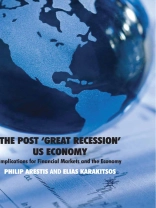The US is slowly recovering from the aftermath of the burst of the ‘new economy’ bubble – which was one of the worst in monetary history. In this updated edition, Philip Arestis and Elias Karakitsos examine the causes and consequences of the burst of the ‘new economy’ bubble and investigate the impact on financial markets.
Cuprins
Prolegomena Preface Introduction The Causes and Consequences of the Internet Bubble The Current Financial Crisis and the Origins of Excessive Liquidity Wages and Prices and the Proper Conduct of Monetary Policy Corporate Profits and Relationship to Investment Long-Term Risks of Investment Recovery The Housing Market and Residential Investment Long-Term Risks of Robust Consumer Behaviour Foreign Demand The US External Imbalance and the Dollar: A Long-Term View The Long-term Risks to Financial Markets Bibliography
Despre autor
PHILIP ARESTIS is Honorary Senior Departmental Fellow, Cambridge Centre for Economic and Public Policy (CCEP), Department of Land Economics, University of Cambridge, UK; Professor of Economics, Department of Applied Economics V, University of the Basque Country, Spain; and Senior Research Fellow at the Levy Institute, New York City. His Publications include Introducing Macroeconomic Modelling: An Econometric Study of the United Kingdom and Money, Pricing Distribution and Economic Integration. He has been editor and joint editor, and has served on the editorial board, of a number of journals.
ELIAS KARAKITSOS is Director of Guildhall Asset Management, chairman of Global Economic Research, and Associate Member of the Centre for Economic and Pubic Policy, University of Cambridge. He was a professor at Imperial College, Head of Economics for 10 years and has acted as an advisor to governments and financial institutions, including Citibank, Oppenheimer, Allianz, Crédit Agricole and Standard Chartered. He is the author of five books/monographs, 90 papers in learned journals and more than 330 reports on financial markets.












